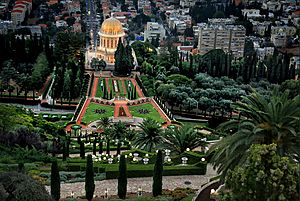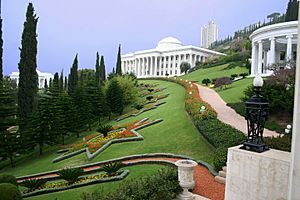Baháʼí World Centre facts for kids
The Baháʼí World Centre is the main spiritual and administrative home of the Baháʼí Faith. It is located in or near the cities of Acre and Haifa, Israel.
This is where important decisions are made for the Baháʼí Faith worldwide. It's also where Baháʼí holy writings are studied and translated. The Universal House of Justice, which is the highest governing body of the Baháʼí Faith, is located in Haifa. The Baháʼí World Centre is a popular place for religious visitors and for Baháʼí pilgrimage, with about one million visitors each year.
The Baháʼí World Centre is in Israel because Baháʼu'lláh, the founder of the Baháʼí Faith, was sent to prison in Acre in 1868 by the rulers of that time.
Many parts of the Baháʼí World Centre, like the beautiful terraces and the Shrine of the Báb on Mount Carmel, were added to the World Heritage List in July 2008. This means they are considered very important cultural sites for everyone.
Contents
History of the Centre
The Baháʼí administrative centre ended up in Israel because Baháʼu'lláh, the founder of the Baháʼí Faith, was sent away and imprisoned many times. In 1853, Baháʼu'lláh was sent away from Persia (now Iran). He went to Baghdad. Later, the ruler of the Ottoman Empire sent him even further away, and finally to Acre in 1868.
Baháʼu'lláh lived the rest of his life in this area. He communicated with his followers across the Middle East, Central Asia, and India using special messengers. Acre became the centre for the growing number of Baháʼí groups. When Baháʼu'lláh's imprisonment became less strict, the area also became a place for Baháʼí pilgrimage. Baháʼís would travel long distances to see Baháʼu'lláh.
Baháʼu'lláh told his son, ʻAbdu'l-Bahá, that the Shrine of the Báb should be built on Mount Carmel in Haifa. Baháʼu'lláh also wrote about establishing the administrative centre of the Baháʼí Faith on Mount Carmel in his Tablet of Carmel. This writing is seen as an important guide for how the Baháʼí administration should be set up.
Baháʼu'lláh passed away in 1892 near Acre. His resting place is in Bahji. After his death, his son ʻAbdu'l-Bahá became the head of the Baháʼí Faith. The area continued to be the centre of Baháʼí activities. He kept in touch with Baháʼís all over the world, including those in Western countries. Even though he was still officially a prisoner in Acre, ʻAbdu'l-Bahá arranged for the remains of the Báb to be brought from Iran to Palestine. He bought the land on Mount Carmel that Baháʼu'lláh had chosen for the Báb's resting place. He also oversaw the building of the Shrine of the Báb. This project took 10 years and was finished in 1909.
In 1908, a revolution in the Ottoman Empire freed all political prisoners. This meant ʻAbdu'l-Bahá was also freed. Soon after, he moved to Haifa, close to the Shrine of the Báb. Since then, the main administrative offices of the Baháʼí Faith have been in Haifa. As ʻAbdu'l-Bahá got older, more and more letters were being sent. So, he hired many secretaries, including some who spoke Western languages. A Pilgrim House was also set up for visitors. ʻAbdu'l-Bahá passed away in 1921 and was buried in a room at the Shrine of the Báb in Haifa.
After ʻAbdu'l-Bahá's death, Shoghi Effendi became the head of the Baháʼí Faith. He started many projects in the area. In 1929, he renovated Baháʼu'lláh's house in Bahji. In the 1950s, he legally secured the lands around the building and created beautiful gardens. He also gained ownership of other important sites near Acre connected to Baháʼu'lláh's life. In Haifa, he made the Shrine of the Báb larger by adding its famous golden dome. He also bought land around the Shrine to create more gardens.
Shoghi Effendi decided that the main Baháʼí institutions, like the Universal House of Justice, would be built in the shape of an arc, surrounded by gardens. The centre of this arc would be the Monument Gardens, where members of the Baháʼí holy family are buried. During his lifetime, he began building one of the structures in the arc, the International Archives building. He also worked to make sure Baháʼí properties did not have to pay taxes. In 1987, the Israeli government officially recognized the Baháʼí Faith as a religion in Israel. They also confirmed that the Universal House of Justice manages the Baháʼí Holy Places and properties in Israel.
Important Buildings
The other buildings that form the Arc are the Seat of the Universal House of Justice, the Centre for the Study of the Sacred Texts, and the Seat of the International Teaching Centre. These were finished in 1982, 1999, and 2000. A fifth building, the International Baháʼí Library, is planned for the eastern end of the Arc. It is expected to be a centre for "knowledge in all fields," including science. The beautiful terraces around the Shrine of the Báb were finished in 2001.
How the Centre is Run
Most of the international management and planning for the Baháʼí Faith happens at the Baháʼí World Centre. This includes making global decisions for the religion and studying and translating the Baháʼí holy writings. The Universal House of Justice, the highest governing body, is in Haifa. Also in Haifa is the International Teaching Centre, which helps coordinate activities around the world and connects with the Universal House of Justice.
Staff at the Centre
During Shoghi Effendi's time as head of the Baháʼí Faith, the area was called Mandatory Palestine. There was a growing conflict between different groups there. When the British rule ended in 1948, and a war started, most Baháʼís in Israel left. Only Shoghi Effendi and a few others stayed. In 1963, the first Universal House of Justice was elected, with its home in Haifa. Since then, the number of support staff in Haifa has grown to several hundred people from over sixty countries. This growth happened because the Baháʼí community around the world grew. The staff includes people who work in different departments like research, finance, and maintaining the gardens and buildings.
It's interesting that even though there are hundreds of Baháʼí staff members in Haifa and Acre, there isn't a formal Baháʼí community in Israel. This means there are no regular local meetings or groups for Baháʼís in Israel. Also, since the time of Baháʼu'lláh, Baháʼís have chosen not to teach their religion to people who live in Israel. People from Israel cannot officially become Baháʼís. In a letter from 1995, the Baháʼí Universal House of Justice explained:
...the people in Israel have access to factual information about the Faith, its history and general principles. Books concerning the Faith are available in libraries throughout Israel, and Israelis are welcome to visit the Shrines and the surrounding gardens. However, in keeping with a policy that has been strictly followed since the days of Baháʼu'lláh, Baháʼís do not teach the Faith in Israel. Likewise, the Faith is not taught to Israelis abroad if they intend to return to Israel. When Israelis ask about the Faith, their questions are answered, but this is done in a manner which provides factual information without stimulating further interest.
In 2002, Israel's Finance Ministry suggested changing an agreement with the Baháʼí World Centre. They wanted the Baháʼís to hire more Israelis at their centres in Haifa.
Local Israelis and the Baháʼí World Centre staff usually don't have much contact. Even staff members who have lived in Israel for many years often don't speak Hebrew or Arabic.
Local Views
Some researchers from the University of Haifa talked to 29 people from Haifa who were affected by the Baháʼí World Centre's expansion from the late 1980s to the 1990s. This construction included new gardens, terraces, and buildings. It all officially opened in 2001.
The people interviewed saw the site as "a symbol of the city" and "excellently managed and maintained." After the construction, residents noticed good things like money given to the local community centre and Arab students, higher property values, and better environmental quality. However, they also felt "separated" from the site because of fences and controlled access. They felt there was an unfair difference between the beautiful Baháʼí site and their own neighbourhoods.
The city of Haifa and others supported the site's development. They promoted it for its message of religious tolerance, its beauty, its help to the economy through tourism, and for boosting Haifa's international standing. The interviews showed that the expansion caused some disagreements with locals. These disagreements were mainly about planning and local issues, not about religious values. Some people who felt treated unfairly wanted to be able to visit the Baháʼí properties anytime. But the properties have specific visiting hours and guided tours. Some people even called Haifa “a city that became sacred because of the slightly strange and mysterious Baha'i religion."
See also
 In Spanish: Centro Mundial Bahaí para niños
In Spanish: Centro Mundial Bahaí para niños
- Baháʼí gardens
- Religion in Israel (section Baháʼí)





